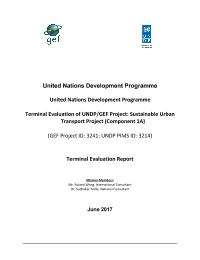
Terminal evaluation - Sustainable Urban Transport
Completedon 8 Jun, 2017
Evaluation Plan
Planned End Date
Dec 2017
Evaluation Type
Project
Management Response
Yes
Evaluation Budget
$25,000
Evaluation Title
Terminal evaluation - Sustainable Urban Transport
Atlas Project Number
00048794
Plan Period
Status
Completed
Type
Project
Plan Date
1 Dec, 2017
Completion Date
8 Jun, 2017
Budget
$25,000
Expenditure
$21,000
Management Response
Yes
Quality Assessment
Yes
Joint Programme
No
Joint Evaluation
No
GEF Evaluation
Yes
Expand
Countries
India
Atlas Project Number
00048794
Plan Period
Status
Completed
Type
Project
Management Response
Yes
Plan Date
1 Dec, 2017
Quality Assessment
Yes
Completion Date
8 Jun, 2017
Joint Programme
No
Joint Evaluation
No
Budget
$25,000
GEF Evaluation
Yes
Expand
Expenditure
$21,000
Countries
India
Output 5.2. Effective institutional, legislative and policy frameworks in place to enhance the implementation of disaster and climate risk management measures at national and sub-national levels
1: Others


